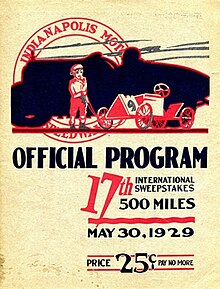 | |||||
| Indianapolis Motor Speedway | |||||
|---|---|---|---|---|---|
| Indianapolis 500 | |||||
| Sanctioning body | AAA | ||||
| Date | May 30, 1929 | ||||
| Winner | Ray Keech | ||||
| Winning Entrant | Maude A. Yagle | ||||
| Average speed | 97.585 mph (157.048 km/h) | ||||
| Pole position | Cliff Woodbury | ||||
| Pole speed | 120.599 mph (194.085 km/h) | ||||
| Most laps led | Louis Meyer (65) | ||||
| Pre-race | |||||
| Pace car | Studebaker President Roadster | ||||
| Pace car driver | George Hunt | ||||
| Starter | Larry P. Fisher[1] | ||||
| Honorary referee | Harvey S. Firestone[1] | ||||
| Estimated attendance | 160,000[2] | ||||
| Chronology | |||||
| |||||
The 17th International 500-Mile Sweepstakes was held at the Indianapolis Motor Speedway on Thursday, May 30, 1929. Ray Keech, who finished fourth a year earlier, took the lead for the final time on lap 158 and won his first Indianapolis 500. Keech won for car owner Maude A. Yagle, the first and to-date, only female winning owner in Indy history. Only two weeks after winning the race, Ray Keech was fatally injured in a crash at Altoona Speedway on June 15, 1929. The race was part of the 1929 AAA Championship Car season.
The 1929 edition was the last contested with the supercharged 911⁄2 cu. in. (1.5 L) displacement engine formula. The supercharged front-wheel drive Miller 8s dominated qualifying, sweeping the front row. A total of twelve front-wheel drive machines made the field, but Keech's rear-wheel-drive Simplex Piston Ring Special took the victory. All three cars of the front row, as well as the first two cars of the second row, dropped out before the halfway point. Pole-sitter Cliff Woodbury crashed on lap 4, and became the first pole position winner in Indy history to finish last (33rd). Defending race winner Louis Meyer was leading in the second half, but lost nearly seven minutes when his car stalled in the pits due to low oil pressure on lap 157. He finished second just over six minutes behind Keech, with the lengthy pit stop the deciding margin.
The hard luck story of the race belonged to Lou Moore. After finishing second in 1928, Moore was on his way to back-to-back runner-up finishes. With two laps to go, however, his engine threw a rod. Due to the rules at the time, since Moore was not running at the finish, he was scored behind all finishers. He fell all the way back to 13th position, behind four cars that actually had fewer laps than he had.
It was the final race of the Roaring Twenties and the final race before the Stock Market Crash and Great Depression. The facility was expanded in 1929 to include a golf course.[3] Dubbed the "Speedway Golf Course," it featured nine holes outside the track, and nine holes inside the track, and was designed by Bill Diddel.[4] Also during the month, scenes for the movie Speedway were being filmed.
- ^ a b Fox, Jack C. (1994). The Illustrated History of the Indianapolis 500 1911-1994 (4th ed.). Carl Hungness Publishing. p. 22. ISBN 0-915088-05-3.
- ^ Patton, W. Blaine (May 31, 1929). "Meyer Captures Second, Gleason Speeds In Third". The Indianapolis Star. p. 1. Retrieved June 3, 2017 – via Newspapers.com.

- ^ "Speedway Will Open Public Golf Grounds". The Indianapolis News. April 17, 1928. p. 21. Retrieved February 3, 2016 – via Newspapers.com.

- ^ "The Golf Courses of Bill Diddel". Archived from the original on 2016-02-01. Retrieved 2016-02-03.